Osgood parameter values for 1000 words of the Russian language
The article describes the methodology of data collection for the formation of affective norms for 1000 frequent words of the Russian language according to the parameters arousal (intensity of emotional reaction when perceiving a word) and dominance (feeling of strength or weakness when perceiving a word). This study supplements the scores collected earlier on the parameter valence (positivity/negativity of the word). The scores on the three scales (hereafter, VAD) are derived from the classical factor analysis parameters described by Ch. Osgood. Since the middle of the 20th century, numerical data on VAD scales for different groups of words have been collected from different languages, and the development of information technology and big data collection methods now allows us to obtain ratings on affective parameters for a wide sample of stimulus words. Databases of VAD ratings have been created for a large set of words from English, Dutch, Spanish, German and a number of other languages. Prior to the present study, these parameters have not been studied for a large list of Russian stimulus words. Such resources are an important source for the realization of research in the field of cognitive sciences, psycholinguistics and computer-aided text mining, for example, in sentiment analysis, which indicates the relevance of creating databases of affective norms. However, until the present study, these parameters have not been studied on the material of a voluminous list of stimulus words of the Russian language. In this paper, firstly, the methodology of collecting arousal and dominance scores for 1000 words of the Russian language is described in detail; secondly, the relationship between the VAD scales is described; thirdly, the role of gender differences in the formation of arousal and dominance parameters is investigated; fourthly, the features of affective parameters of the semantic group of words “diseases” are analyzed. An important result is the obtained database of Russian words with ratings by VAD parameters, the revealed correlations between the scales and the described features of word evaluation by these parameters. In addition, the article demonstrates the consistency of the data we obtained with ratings created for other languages, which indicates, on the one hand, the reliability of the results obtained, on the other hand, the language-wide tendency of word perception by affective parameters.
Figures


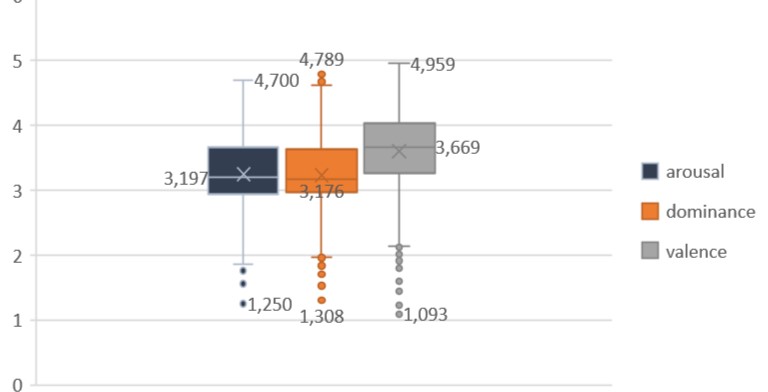
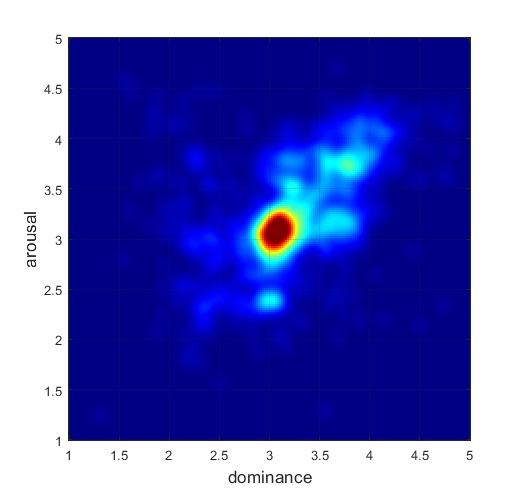
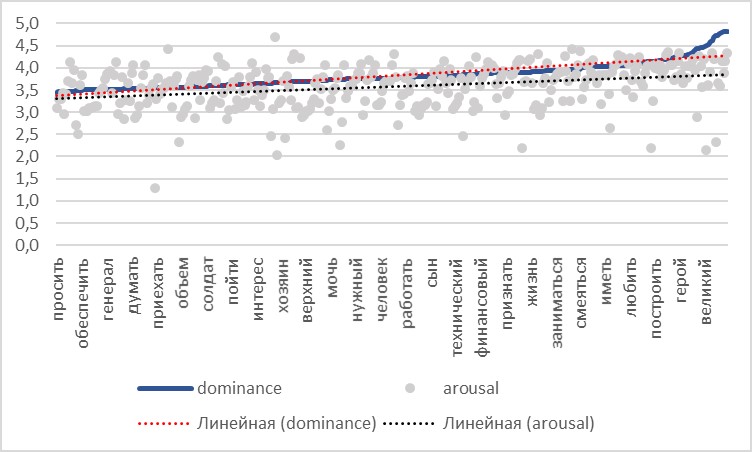
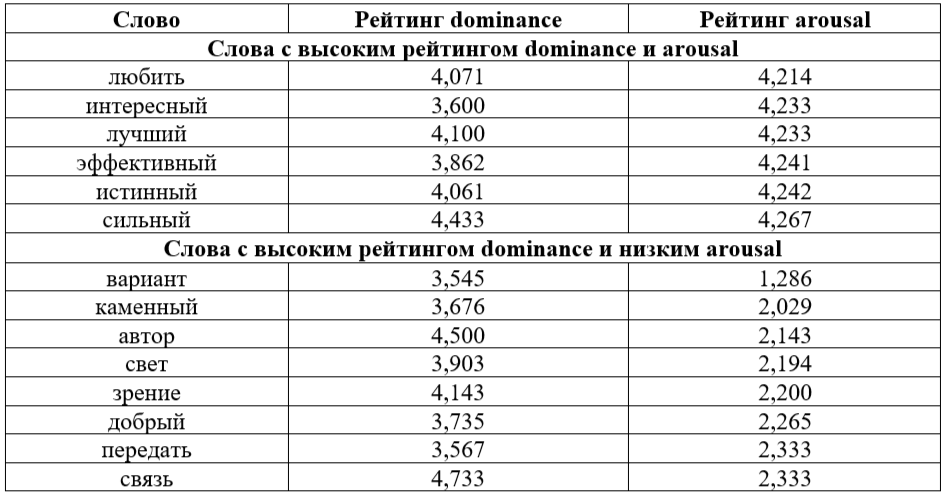
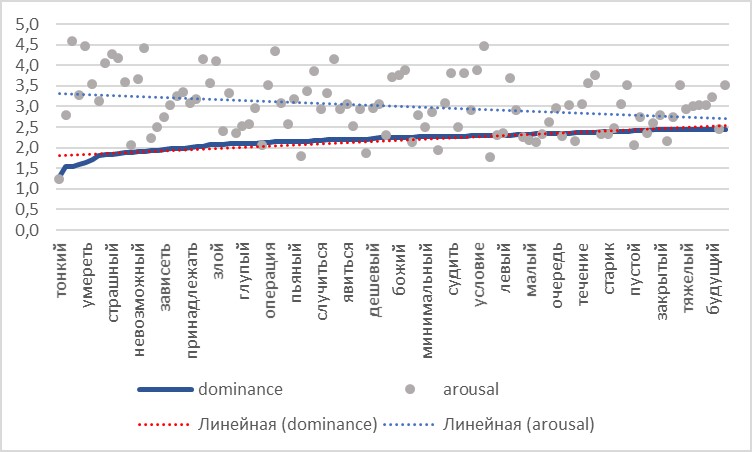
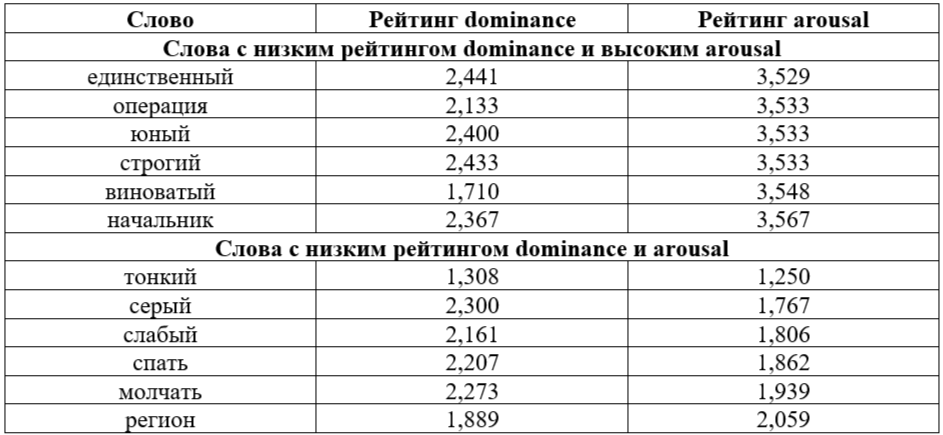
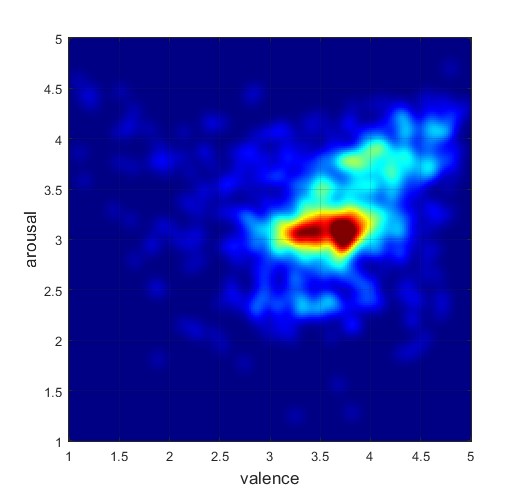
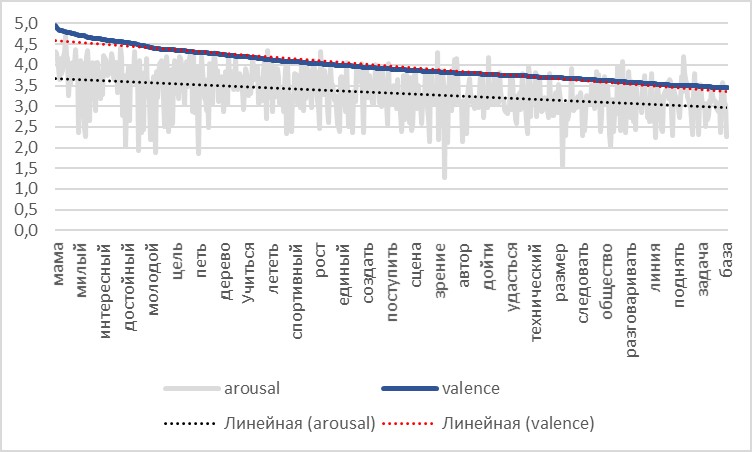
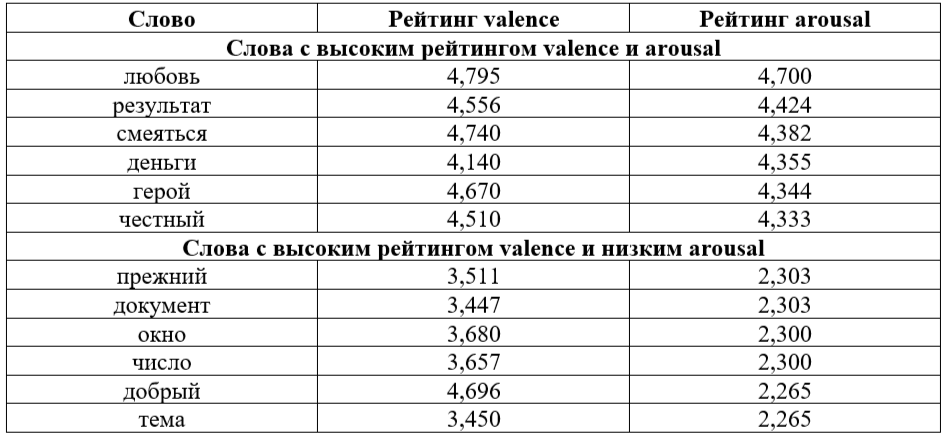
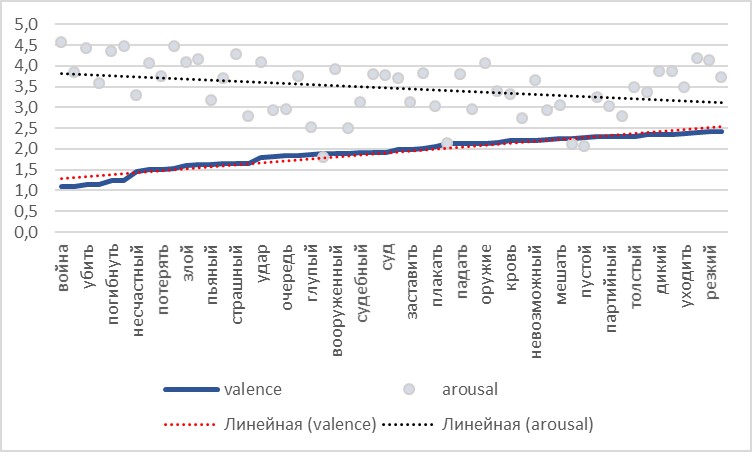
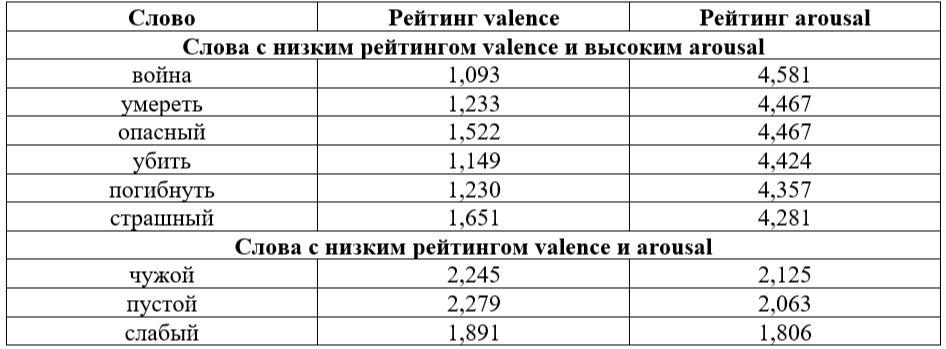
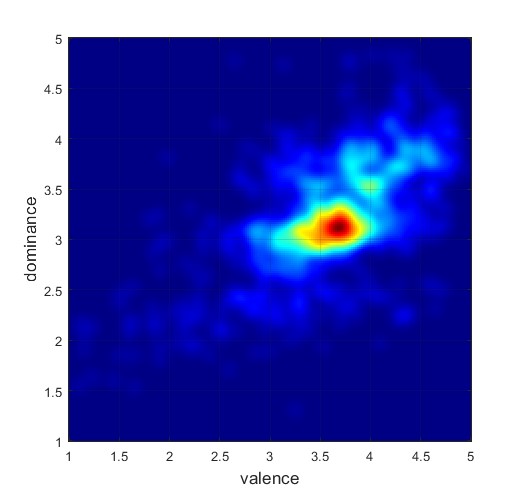
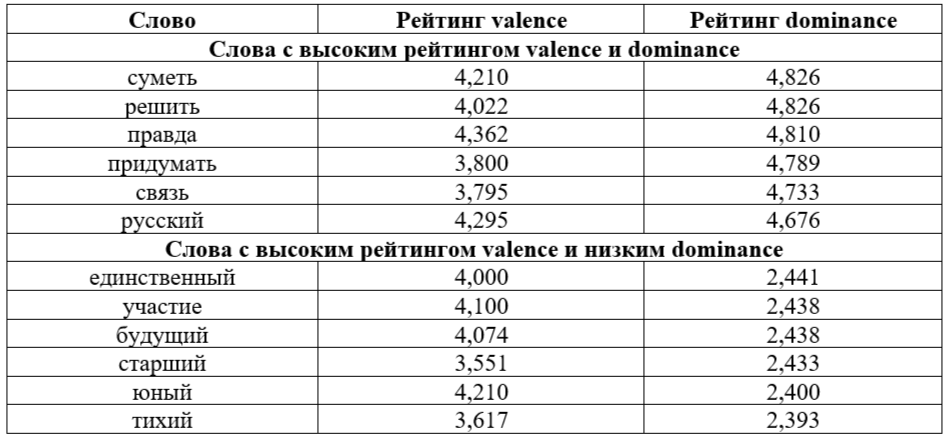
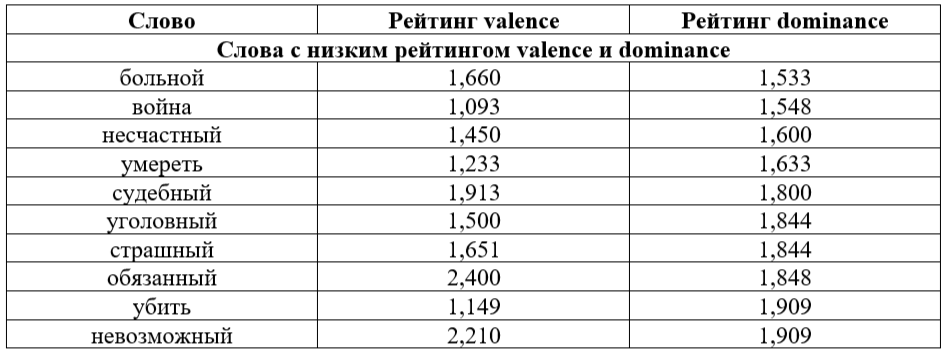
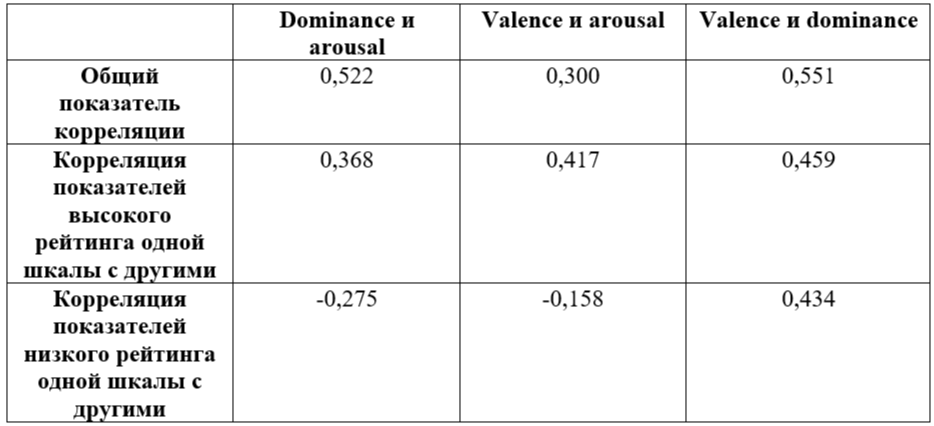

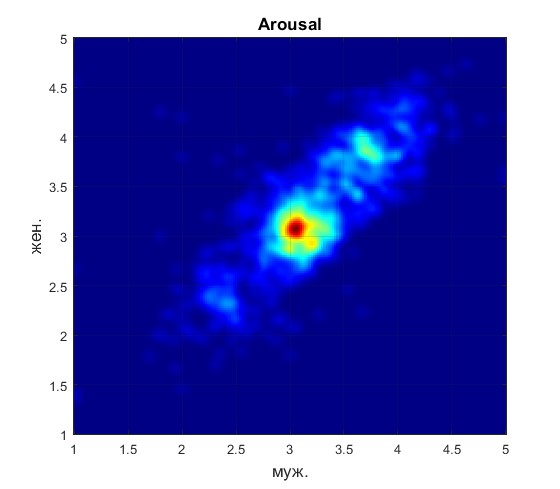
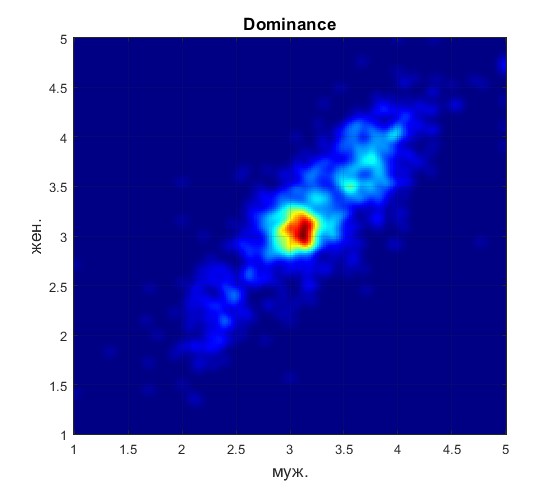
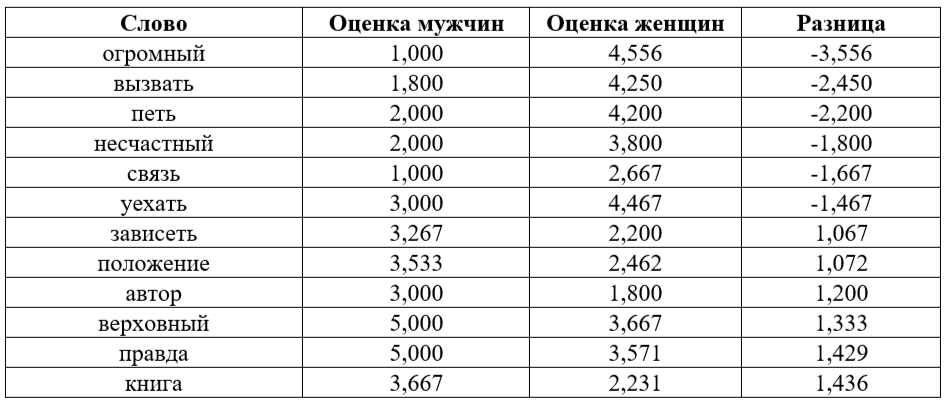
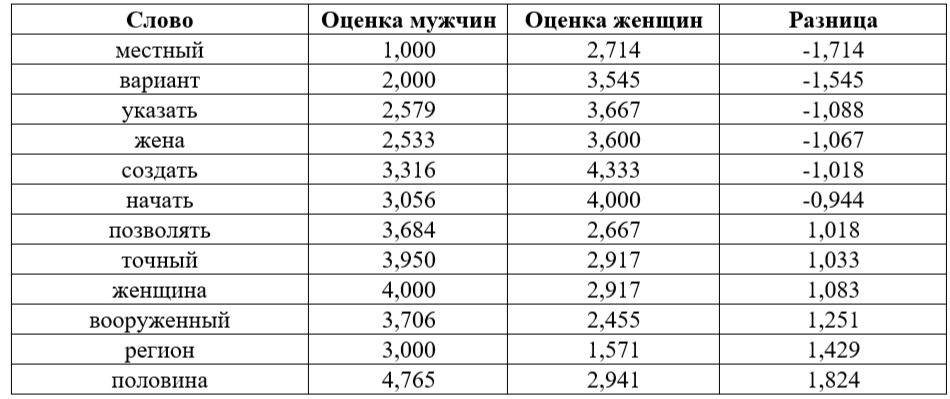
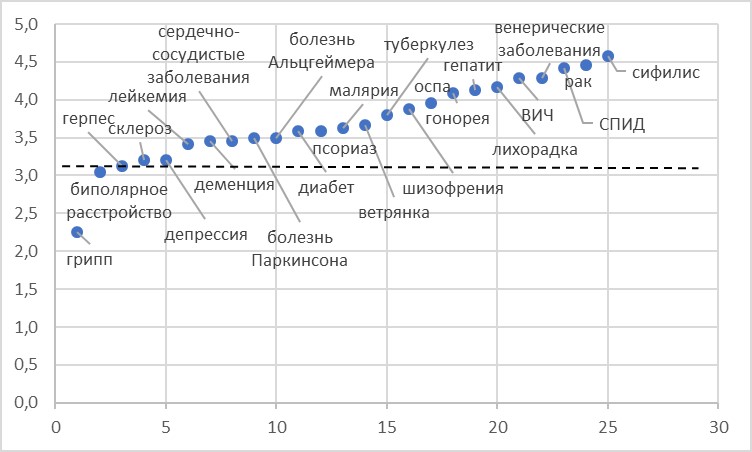

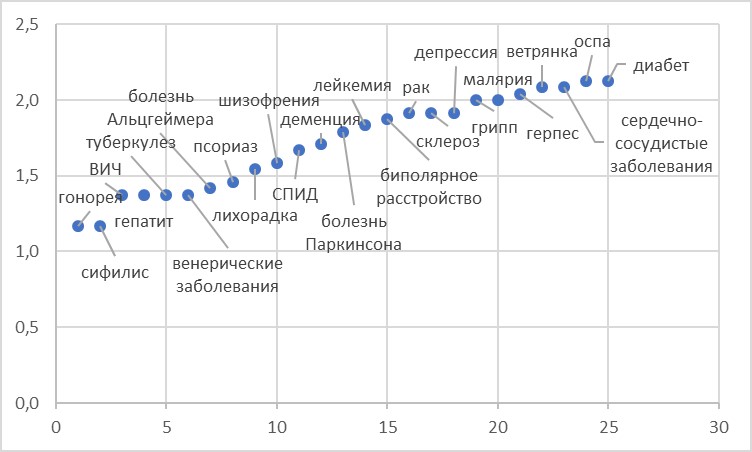

Solovyev, V. D., Volskaya, Yu. A., Toksubaeva, A. A. (2025). Osgood parameter values for 1000 words of the Russian language, Research Result. Theoretical and Applied Linguistics, 11 (1), 72-106.


















While nobody left any comments to this publication.
You can be first.
Volskaya, Yu. A. (2024). Specificity of lexico-grammatical discharges of concreteness and abstractness in the Russian language: an experimental approach, Ph.D. Thesis, Kazan, Russia. (In Russian)
Grigorev, A. A., Pashneva, S. A. (2022). Concreteness-abstractness scores for 1200 words of the Russian language, Teoriya yazyka i mezhkulturnaya kommunikatsiya, 3 (46), 33-72. (In Russian)
Malov, A. A. (2016). Databases of affective language norms as a way of systematising affective vocabulary, Uspekhi sovremennoy nauki, 3, 141-148. (In Russian)
Marchenko, O. P. (2010). A psycholinguistic database for semantic categories, Eksperimentalnaya psikhologiya v Rossii: traditsii i perspektivy [Experimental Psychology in Russia: Traditions and Prospects], Moscow, Russia, 404-408. (In Russian)
Rezanova, Z. I., Miklashevskiy, Z. I. (2016). Modelling the image-perceptual component of linguistic semantics using a psycholinguistic database, Vestnik Tomskogo gosudarstvennogo universiteta, 5 (43), 71-92. DOI: 10.17223/19986645/43/6 (In Russian)
Solovyev, V. D., Volskaya, Yu. A., Andreeva, M. I. and Zaikin, A. A. (2022). Russian language dictionary with concreteness/abstractness indices, Russian Journal of Linguistics, 2, 515-549. DOI: 10.22363/2687-0088-29475 (In Russian)
Bellezza, F. S., Greenwald, A. G. and Banaji, M. R. (1986). Words high and low in pleasantness as rated by male and female college students, Behavior Research Methods, Instruments & Computers, 18, 299-303. DOI: 10.3758/BF03204403 (In English)
Bonin, P., Méot, A. and Bugaiska, A. (2018). Concreteness norms for 1,659 French words: Relationships with other psycholinguistic variables and word recognition times, Behavior Research Methods, 50 (6), 2366–2387. DOI: 10.3758/s13428-018-1014-y (In English)
Bradley, M. M., Lang, P. J. (1994). Measuring emotion: The selfassessment manikin and the semantic differential, Journal of Behavioral Therapy and Experimental Psychiatry, 25, 49–59. DOI: 10.1016/0005-7916(94)90063-9 (In English)
Bradley, M. M., Lang, P. J. (1999). Affective Norms for English Words (ANEW): Instruction Manual and Affective Ratings, Technical report C-1, the center for research in psychophysiology, University of Florida. (In English)
Brysbaert, M., New, B. (2009). Moving beyond Kučera and Francis: A critical evaluation of current word frequency norms and the introduction of a new and improved word frequency measure for American English, Behavior Research Methods, 41, 977–990. DOI: 10.3758/BRM.41.4.977 (In English)
Brysbaert, M., Warriner, A. B. and Kuperman, V. (2014). Concreteness ratings for 40 thousand generally known English word lemmas, Behavior Research Methods, 46 (3), 904–911. DOI: 10.3758/s13428-013-0403-5 (In English)
Ćoso, B., Guasch, M., Ferré, P. and Hinojosa, J. A. (2019). Affective and concreteness norms for 3,022 Croatian words, Quarterly Journal of Experimental Psychology, 72 (9), 2302–2312. DOI: 10.1177/1747021819834226 (In English)
Cronbach L.J. (1951). Coefficient alpha and the internal structure of tests, Psychometrika, 16, 297–334. DOI:10.1007/BF02310555
Duchon, A., Perea, M., Sebastián-Gallés, N., Martí, A. and Carreira, M. (2013). EsPal: One-stop shopping for Spanish word properties, Behavior Research Methods, 45, 1246–1258. DOI: 10.3758/s13428-013-0326-1 (In English)
Gao, C., Shinkareva, S. V. and Peelen, M. V. (2022). Affective valence of words differentially affects visual and auditory word recognition, Journal of Experimental Psychology: General, 151 (9), 2144–2159. DOI: 10.1037/xge0001176 (In English)
Guasch, M., Ferré, P. and Fraga, I. (2016). Spanish norms for affective and lexico-semantic variables for 1,400 words, Behavior Research Methods, 48 (4), 1358–1369. DOI: 10.3758/s13428-015-0684-y (In English)
Imbir, K. K. (2016). Affective Norms for 4900 Polish Words Reload (ANPW_R): Assessments for valence, arousal, dominance, origin, significance, concreteness, imageability and, age of acquisition, Frontiers in Psychology, 7, 1–18. DOI: 10.3389/fpsyg.2016.01081 (In English)
Kousta, S. T., Vigliocco, G., Vinson, D. P., Andrews, M. and Del Campo, E. (2011). The representation of abstract words: Why emotion matters, Journal of Experimental Psychology. General, 140, 14–34. DOI:10.1037/a0021446 (In English)
Kousta, S. T., Vinson, D. P. and Vigliocco, G. (2009). Emotion words, regardless of polarity, have a processing advantage over neutral words, Cognition, 112, 473–481. DOI: 10.1016/j.cognition.2009.06.007 (In English)
Kuperman, V., Stadthagen-Gonzalez, H. and Brysbaert, M. (2012). Age-of-acquisition ratings for 30,000 English words, Behavior Research Methods, 44, 978–990. DOI: 10.3758/s13428-012-0210-4 (In English)
Lahl, O., Göritz, A. S., Pietrowsky, R. and Rosenberg, J. (2009). Using the World-Wide web to obtain large-scale word norms: 190,212 ratings on a set of 2,654 German nouns, Behavior Research Methods, 41(1), 13–19. DOI: 10.3758/BRM.41.1.13 (In English)
Likert, R. A (1932). Technique for the Measurement of Attitudes, Archives of Psychology, 140, 1–55. (In English)
Marful, A., Díez, E. and Fernandez, A. (2014). Normative data for the 56 categories of Battig and Montague (1969) in Spanish, Behavior Research Methods, 47, 902–910. DOI: 10.3758/s13428-014-0513-8 (In English)
Martín-Loeches, M., Fernández, A., Schacht, A., Sommer, W., Casado, P., Jiménez-Ortega, L. and Fondevila, S. (2012). The influence of emotional words on sentence processing: Electrophysiological and behavioral evidence, Neuropsychologia, 50, 3262–3272. (In English)
Mehrabian, A., Russell, A. (1974). An approach to environmental psychology, M.I.T. Press, Cambridge, UK. (In English)
Mohammad, S. M. (2018). Obtaining Reliable Human Ratings of Valence, Arousal, and Dominance for 20,000 English Words, Proceedings of the 56th Annual Meeting of the Association for Computational Linguistics, 1, 174-184. DOI: 10.18653/v1/P18-1017 (In English)
Monnier, C. and Syssau, A. (2013). Affective Norms for French Words (FAN), Behavior Research Methods, 46(4), 1128-1137. DOI:10.3758/s13428-013-0431-1 (In English)
Montefinese, M., Ambrosini, E., Fairfield, B. and Mammarella, N. (2013). The adaptation of the Affective Norms for English Words (ANEW) for Italian, Behavior Research Methods, 46(3), 887-903. DOI: 10.3758/s13428-013-0405-3 (In English)
Moors, A., Houwer, D. J., Hermans, D., Wanmaker, S., Schie, van K., Harmelen, A., Schryver, M., Winne, J. and Brysbaert, M. (2012). Norms of valence, arousal, dominance, and age of acquisition for 4,300 Dutch words, Behavior Research Methods, 45, 169–177. DOI: 10.3758/s13428-012-0243-8 (In English)
Osgood, C. E., Suci, G. and Tannenbaum, P. (1957). The measurement of meaning, University of Illinois Press, Champaign, Illinois. (In English)
Ponari, M., Norbury, C. F., Rotaru, A., Lenci, A. and Vigliocco, G. (2018). Learning abstract words and concepts: Insights from developmental language disorder, Philosophical Transactions of the Royal Society B: Biological Sciences, 373(1752), 20170140. DOI: 10.1098/rstb.2017.0140 (In English)
Redondo, J., Fraga, I., Padrón, I. and Comesaña, M. (2007). The Spanish adaptation of ANEW (Affective Norms for English Words), Behavior Research Methods, 39, 600–605. DOI: 10.3758/BF03193031 (In English)
Riegel, M, Wierzba, M, Wypych, M, Żurawski, Ł, Jednoróg, K, Grabowska, A. and Marchewka A. (2015). Nencki Affective Word List (NAWL): the cultural adaptation of the Berlin Affective Word List–Reloaded (BAWL-R) for Polish, Behavior Research Methods, 47, 1222-1236. DOI: 10.3758/s13428-014-0552-1 (In English)
Russell, J. A. (1980). A circumplex model of affect, Journal of personality and social psychology, 39(6), 1161-1178. DOI:10.1037/h0077714 (In English)
Soares, A. P., Comesaña, M., Pinheiro, A. P. Simões, A. and Frade, C. S. (2012). The adaptation of the Affective Norms for English Words (ANEW) for European Portuguese, Behavior Research Methods, 44, 256–269. DOI: 10.3758/s13428-011-0131-7 (In English)
Solovyev, V., Islamov, M. and Bayrasheva, V. (2022). Dictionary with the evaluation of positivity/negativity degree of the Russian words. Lecture Notes in Computer Science, 13721, 651–664. DOI:10.1007/978-3-031-20980-2_55 (In English)
Speed, L. J., Brysbaert, M. (2023). Ratings of valence, arousal, happiness, anger, fear, sadness, disgust, and surprise for 24,000 Dutch words, Behavior Research Method, 56, 5023-5039. DOI: 10.3758/s13428-023-02239-6 (In English)
Stadthagen-Gonzalez, H., Imbault, С., Pérez Sánchez, M. A. and Brysbaert, M. (2016). Norms of valence and arousal for 14,031 Spanish words, Behavior Research Methods, 49, 111-123. DOI: 10.3758/s13428-015-0700-2 (In English)
Syssau, A. and Laxén, J. (2012). L’influence de la richesse sémantique dans la reconnaissance visuelle des mots émotionnels, Canadian Journal of Experimental Psychology, 66, 70–78. DOI: 10.1037/a0027083 (In English)
Van Overschelde, J. P., Rawson, K. A. and Dunlosky, J. (2004). Category norms: An updated and expanded version of the Battig and Montague (1969) norms, Journal of Memory and Language, 50, 289–335. DOI: 10.1016/j.jml.2003.10.003 (In English)
Verona, E., Sprague, J. and Sadeh, N. (2012). Inhibitory control and negative emotional processing in psychopathy and antisocial personality disorder, Journal of Abnormal Psychology, 121, 498–510. DOI: 10.1037/a0025308 (In English)
Vinson, D., Ponari, M. and Vigliocco, G. (2014). How does emotional content affect lexical processing?, Cognition and Emotion, 28 (4), 737–746. DOI: 10.1080/02699931.2013.851068 (In English)
Võ, M. L. H., Conrad, M., Kuchinke, L., Urton, K., Hofmann, M.J. and Jacobs, A.M. (2009). The Berlin Affective Word List Reloaded (BAWL-R), Behavior Research Methods, 41, 534–538. DOI: 10.3758/BRM.41.2.534 (In English)
Warriner, A. B., Kuperman, V. and Brysbaert, M. (2013). Norms of valence, arousal, and dominance for 13,915 English lemmas, Behavior Research Methods, 45, 1191–1207. DOI: 10.3758/s13428-012-0314-x (In English)
Xu Xu, Li J., Chen H. (2021). Valence and arousal ratings for 11,310 simplified Chinese words, Behavior Research Methods, 54, 26–41. DOI: 10.3758/s13428-021-01607-4 (InEnglish)
The research was funded by the Russian Science Foundation (project No. 24-18-00570, https://rscf.ru/project/24-18-00570/)